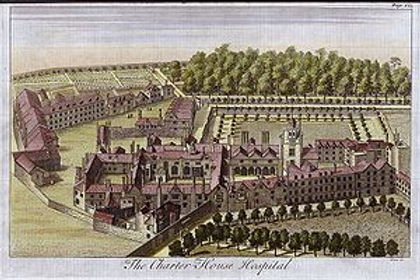Jane Elizabeth Beckwith Early life
Clerkenwell 1805-1830
Jane Elizabeth Beckwith, was the second child and first daughter of Joseph and his young wife Jane Pittard. As such she was named after her mother. She had a maternal aunt Elizabeth, but I would think it unlikely that she was named after an aunt, but you never know. In any case Elizabeth was not the name of either of her grandmothers. It was a close-knit family though - her other aunt Susannah lived with her for many years in her later life and seems to have acted much like a loving grandmother, or the honoured spinster aunt I guess. and interestingly, and somewhat weirdly, Jane's father was buried in the same grave as Susannah.
She was born in the Parish of St. John Clerkenwell “on Clerkenwell Green”, on August 20th 1805, but baptised in the church of St. James, which is the church in the picture at left. The church had been rebuilt a few years before her birth, hence it’s more modern look. Clerkenwell Green is shown in the engraving at right. The reference to “on Clerkenwell Green “ is from Dawn Sorensen’s family bible. One hopes she was not literally born on the Green, but rather in a house that was situated at Clerkenwell Green. Her older brother Joseph was also born here. Clerkenwell is the area just to the north and east of Smithfield and Holborn where her future husband grew up. Pretty much just on the edge of the city of London proper and nowadays a very fashionable, trendy and arty place to be.






She probably lived for all of her pre-married life in Wilderness Row where her father worked as an engraver and silversmith. Wilderness Row no longer exists, it being virtually torn up in late nineteenth century infrastructure improvements. In the rather beautiful engraving at left it is the road running just below the trees, and to the north of the Charterhouse complex - school and hospital. The map at the top of the page details the numbers of the houses in the street, although it doesn’t number all of them. However, following the numbering, no.25 would have been at the west end of the street on the north side, the south side, being just fields. The map was drawn in 1792, a little earlier, but there would have been no great changes between then and Jane’s birth. It looks very pleasant and rural almost, but probably wasn’t! At least for a time, Joseph’s brother Robert seems to have lived with them. At least his address is given as the same in a listing of silversmiths. It is possible, however, that he just worked there with Joseph, but lived elsewhere.

In contrast to most families of the time, Joseph and Jane do not appear to have churned out children every other year, the gap is more like four years. There are dozens of reasons for this, of course - lower fertility, miscarriages in between, absence, less sex. Who knows, but the end result would have been a bit more attention for the children you would think. That attention probably didn’t extend to formal schooling for the girls though. They were not rich after all. Any schooling that Jane had (and she could at least read and write), was most likely given to her by her mother, who would also have trained her in the housewifely arts. Indeed the housewifely arts were probably the most important things she learnt.


Because of the gap between children the family was small, three boys and two girls born between 1801 and 1816, which is quite a large span. Her sister Mary Ann, with whom she seems to have had a close relationship was six years younger than her. And so there would probably have been time to play as well as learn how to be a model young lady. Her parents marriage cannot have ultimately been a happy one, as Joseph’s story will show - he had a very long-running affair with another woman from the 1830s onwards. But there may well have been many happy years before that. In a note on her father’s death, Jane describes her father as a ‘“a consistent and honest Radical”. (Thanks to Dawn Sorensen for this.)

This was the Regency age, the era of the Napoleonic wars, with the French and American Revolutions a fairly recent memory. Society was in ferment, the populace was stirring and beginning to demand more rights, and it seems that Joseph took some part, even if only on an intellectual basis, in all of this. The London coffee houses were full of discussion and argument, and Joseph was also part of this, as his second career was as a coffee-house keeper. My guess is that this meant that he was not much at home, and that the children would have been overwhelmingly in their mother’s hands, rather than their father’s. Jane loved her - on her death in 1830 she wrote: (again thanks to Dawn), “she was a practical economist, her domestic arrangements were a perfect specimen of order, neatness, frugality and attention to the interest entrusted to her care. She was a fond mother, an invaluable wife, a woman of surpassing excellence." A paragon and one that I feel Jane tried to emulate in her later life.


And incidentally that faded drawn portrait at the top of the page is actually of Jane herself. And criminally, I have forgotten which of new found Mollett relations sent me this - I am so sorry. Many, many thanks - it is one of my most treasured possessions. (Just one of four of various Mollett ancestors)
Links
How to be a child in Regency England -
It’s a personal blog with all that that means, but a few interesting points are made.
An excellent site with masses of links and information about life in the Regency era